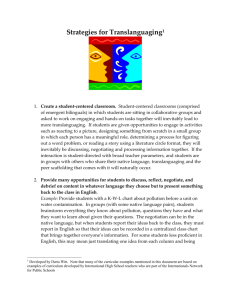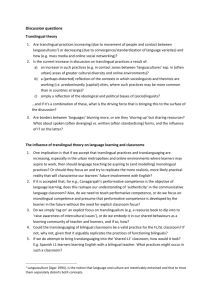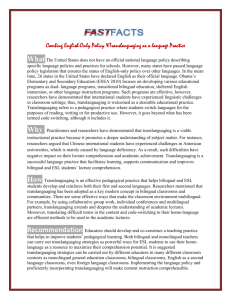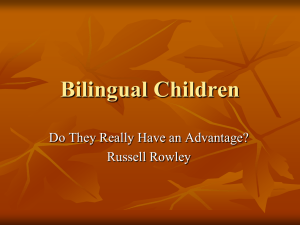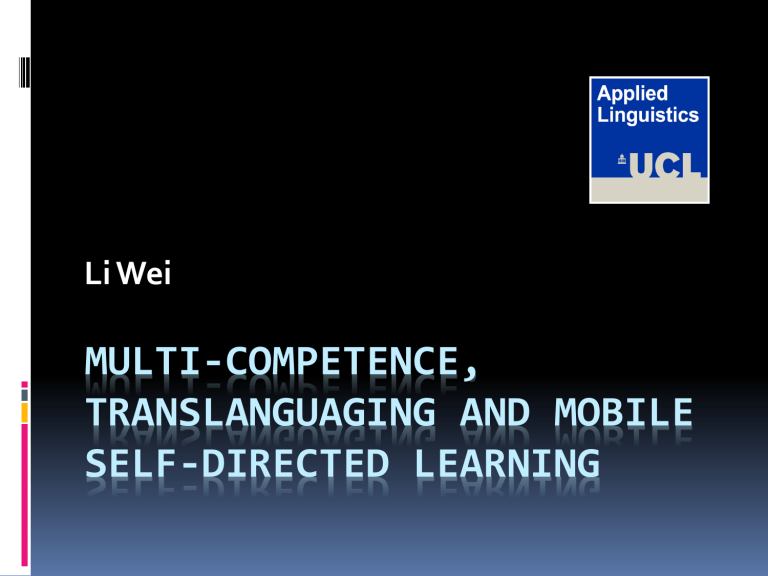
Li Wei MULTI-COMPETENCE, TRANSLANGUAGING AND MOBILE SELF-DIRECTED LEARNING Prevalence of self-directed mobile learning How does the learner make sense of the learning process: resources and strategies How do we as analyst make sense of the learner making sense pf the learning process Two theoretical concepts/frameworks: MC and TLAN Cook, V.J., 1991, The poverty-of-the-stimulus argument and multi-competence. Second Language Research, 7, pp. 103-117. http://www.viviancook.uk/ Linguistic Multi-Competence Target: the Monolingual view of the L2 learner Moving towards a Bilingual view of the L2 user Seeing L2 learning as a process of becoming bilingual, not another monolingual L2 learner/learning: inherent deficit compared to the native speaker Seeing language learning as part of language use/practice L2 user/use: focusing on what they can do, whilst recognizing the difference An improvement on a system-centred approach, e.g. interlanguage, towards a usercentred approach Three premises MC concerns the total system for all languages (L1, L2, Ln) in a single mind or community and their inter-relationships MC does not depend on the monolingual native speaker MC affects the whole mind, i.e. all language and cognitive systems, rather than language alone Implications for research design Looking at interactions between the languages, not one only or one at a time Avoiding ‘the comparative fallacy’ Bringing in other cognitive and semiotic systems, not just narrowly defined ‘linguistic’ What is the purpose of second/foreign/additional language learning? Achieving bilingualism/multilingualism Not to replace L1 Yet, the bilingual and multilingual language user is rarely used as a model in second/foreign/additional language teaching Norm/standard/target – monolingual ‘native’ speaker Leaving aside the myth of ‘the monolingual’, a second/foreign/additional language learner, by definition, can never be another ‘native-speaking monolingual’ in the target language. Disconnection between Language Teaching and Learning and research on Bilingualism and Multilingualism. Myth: Bilinguals = ‘Perfect’, ‘Balanced’ language users with full proficiencies in all their languages. No one can learn the entire language system, whether first, second, or foreign No one knows the entire language system even if it was ‘native’ language/mother tongue Language learning is a life-long process! The Bilingual Knowledge Bilinguals and multilinguals rarely have equal proficiency in all the languages they know and use, even for the socalled simultaneous bilinguals Bilinguals and multilinguals rarely use all their languages equally in all contexts or to equal level. Knowing which language to which to whom and when is an integral part of being bilingual or multilingual. Bilinguals and multilinguals therefore move between what Grosjean calls ‘language modes’. Language mode (Grosjean, 1998) The Bilingual Knowledge Codewitching is a defining behaviour of BEING Bilingual, i.e. in a bilingual mode. Codeswitching is about the management of different language in social interaction - the most important aspect of the Bilingual Knowledge. Codeswitching Control, Activation and Resources (David Green). ‘competitive control’ v. ‘open control’ – A control process model of code-switching, David W. Green and Li Wei, 2014, Language, Cognition and Neuroscience (formerly Language and Cognitive Processes) 29,4: 499-511 Fears of Codeswitching Hugo Baetens Beardsmore, 1987, Who’s afraid of bilingualism? Parental fears Teachers’ fears Cultural fears Society’s / institutions’ / policies’ fears Monolingualism/Linguistic purism – OLON / OLAT Monolingual ideology affecting research design Separation/differentiation is the benchmark for competence Comparisons to monolingual norms Anatoliy Kharkhurin and Li Wei,2015, The role of codeswitching in bilingual creativity and selective attention. International Journal of Bilingual Education and Bilingualism. 18,2: 153-169 Jean-Marc Dewaele and Li Wei, 2013, Is multilingualism linked to a higher tolerance of ambiguity? Bilingualism: Language and Cognition. 16.1: 231-240 Jean-Marc Dewaele, 2012, Multilingualism, empathy and multicompetence. International Journal of Multilingualism 9.4: 352-366 Translanguaging From Codeswitching to Translanguaging: A paradigm shift Traditional focus on structural constraints and separation of languages/linguistic structures is giving way to “integrational” approaches Beyond he narrow conceptualization of ‘language’ Moves/’turns’ to connectivity, fluidity, mobility. Knowing lots of different languages - The-morethe-better approach Mixing of languages Two routes to TLAN: 1. Pedagogical approach to bilingual education Cen Williams (1994): trawsieithu . Colin Baker: ‘translinguifying’ -> translanguaging (Foundations of Bilingual Education and Bilingualism, 2001 ) a pedagogical practice where one receives information through the medium of one language (e.g. English) and gives information through the medium of a different language (e.g. Welsh). It can be practised by both the student and the teacher. It helps to maximise the learner’s bilingual ability in learning. An effective pedagogical practice where the school language or the language-of-instruction is different from the languages of the learners. Breaking ideological divides between indigenous versus immigrant, majority versus minority, and target versus mother tongue languages Translanguaging empowers both the learner and the teacher, transforms the power relations and focuses the process of teaching and learning on making meaning, enhancing experience and developing identity (e.g. Garcia, 2009; Creese and Blackledge, 2015). Translanguaging is not conceived as an object or a linguistic structural phenomenon to describe and analyse, i.e. not a-thing-in-itself, but a practice and a process – a practice that involves dynamic and functionally integrated use of different languages and language varieties through different modalities a process of knowledge construction that goes beyond, i.e. transcending, the boundaries of languages Role of L1 in second / foreign / additional language learning Two routes to TLAN: 2. Languaging A.L. Becker (1991) borrowed the term Languaging from the Chilean biologist and neuroscientist Humberto Maturana and his coauthor Francesco Varela (1980) and invited us to think that ‘there is no such thing as Language, only continual languaging, an activity of human beings in the world’ (p. 34). He reiterated Ortega y Gasset’s (1957) argument that language should not be regarded ‘as an accomplished fact, as a thing made and finished, but as in the process of being made’ (p.242). Swain on Languaging and the socio-cultural theory the cognitive process of negotiating and producing meaningful, comprehensible output as part of language learning as a ‘means to mediate cognition’, i.e. to understand and to problem-solve (2006, p. 97) and ‘a process of making meaning and shaping knowledge and experience through language’ (p. 97). advanced second language learners’ cognitive and affective engagements through languaging whereby ‘language serves as a vehicle through which thinking is articulated and transformed into an artifactual form’ (p. 97). ‘talking-it-through’ meant ‘coming-to-know-whilespeaking’ (Swain and Lapkin, 2002). languaging and thinking, cognizing and consciousness How is the thinking process affected by simultaneous use of multiple languages? Beyond advanced second language learners to include different types of multilingual language users To capture their ‘talking-it-through’ in multiple languages however incomplete or truncated their knowledge of the individual languages may be The entirety of the learner’s linguistic repertoire, rather than knowledge of specific structures of specific languages separately Ecological psychology – distributed cognition Languaging: ‘an assemblage of diverse material, biological, semiotic and cognitive properties and capacities which languaging agents orchestrate in realtime and across a diversity of timescales’ (Thibault, 2016: 9). Nigel Love, Stephen Cowley, Paul Thibault and Sune Steffensen set out to challenge what they call ‘the code view’ of language that sought to identify abstract verbal patterns, morphosyntax or lexicogrammar, divorced from cognitive, affective, and bodily dynamics in realtime and specify the rules for mapping forms to meanings and meanings to forms. They regard language as a second-order construct, the product of first order activity, languaging (Cowley, 2016; Thibault, 2011, 2016; Steffensen, 2001, 2011) ‘Human languaging activity is radically heterogeneous and involves the interaction of processes on many different time-scales, including neural, bodily, situational, social, and cultural processes and events’ (Thilbault, 2016: 3). Grant languaging a primacy over what is languaged! Rethink of language not as an organism-centred entity with corresponding formalism such as phonemes, words, sentences, etc., but as ‘a multi-scalar organization of processes that enables the bodily and the situated to interact with situation, transcending cultural-historical dynamics and practices’ (Thibault, 2016: 5). The divides between the linguistic, the paralinguistic, and the extralinguistic dimensions of human communication are nonsensical. The orchestration of the neural-bodily-worldly skills of languaging. The importance of feeling, experience, history, memory, subjectivity and culture (and ideology and power). On language learning: the novice does not ‘acquire’ language, but rather ‘they adapt their bodies and brains to the languaging activity that surrounds them’. In doing so, ‘they participate in cultural worlds and learn that they can get things done with others in accordance with the culturally promoted norms and values’ (Thibault, 2016: 3). - language socialization; complex dynamic system (Duranti, Ochs and Schieffelin, 2011; The Five Graces Group, 2009). Adding the Trans prefix to Languaging Better captures multilingual language users’ creative and dynamic practices Two further theoretical arguments: (Language and Thought) Multilinguals do not think unilingually, even when they are in a ‘monolingual mode’ and producing one language only for a specific stretch of speech or text. (Modularity of Mind) Human beings think beyond language, and thinking requires the use of a variety of cognitive, semiotic, and modal resources of which language in its conventional sense of speech and writing is only one. Translanguaging Instinct (Li Wei, 2016) Humans have an innate drive to go beyond narrowly defined linguistic cues and transcend the culturally defined language boundaries. Cf. ‘principle of economy’ in linguistic theories e.g. the Minimalist Program, a ‘Principle of Abundance’ is in operation in human communication in real-life social contexts - multiple cues are present simultaneously in producing a message; human beings have a natural instinct to draw on as many different sensory, modal cognitive and semiotic resources as available to them to interpret the meaning intentions whilst assessing the relative relevance and significance of the different cues - cues complement and compensate each other; human beings read them in a coordinated manner rather than singularly A Translanguaging view of Language Language as a multilingual, multisemiotic, multisensory and multimodal resource for senseand meaning-making. Translanguaging Learning in action Learning Chinese via online platforms With Carey Jewitt, Jeff Bezemer, and Jenifer Ho online learning, mobile learning, self- learning, informal learning, and on the learning of Chinese. Informal, mobile learning: learning that is undertaken ‘individually or collectively, on our own without externally imposed criteria or the presence of an institutionally authorised instructor’ (Livingstone, 2000, p. 493). Digital technology allows individuals to learn ‘on the go’, making learning flexible and able to be controlled by individual learners (Selwyn, 2011). The Internet opens up the access to education to an unprecedentedly wide group of audience, with different ‘funds of knowledge’ at their disposal. An individual can be a teacher in one setting, and a learner in another, engaging in the act of knowledge exchange. How individual adult learners of Chinese engage in self-learning via Memrise. The learner ‘George’ – Australian, early 30s, has been teaching in China for about 8 months at timing of recording Using Memrise in addition to one-to-one tuition (spoken Chinese) At the moment I've got a tutor but I just use Memrise for characters, because that's kind of my own study. I told her [my tutor] I don't really want her to take into characters just, just spoken Chinese. I was also using a programme…which is just like a flashcard programme….there's a set of basic Mandarin flashcards and I was using that 'cause I can use it on the phone as well, there's a programme for that, so I was trying to use it for a little bit, but, yeah, a lot of different things I met a few people when I went to China, the first time. They have given me their QQ number. So I downloaded QQ once I was back in Australia and they were sending me messages in Chinese, in characters. And a lot of the time I was just translating through Google Translate, but also that kind of spur me on to start learning the characters as well….I didn't really stick with one thing….over here in China… I started having my tutoring and I found Memrise… The video sample First 500 Characters in Mandarin Chinese. 或 Huò (perhaps) Video Meaning making, involving carefully orchestrated use of multiple semiotic and modal resources - constantly talking to himself, thinking aloud; looking, reading, moving the mouse; typing; reading the picture/image/sign; imagining other pictures/images/signs; create his own sign; trying out the pronunciation or trying to memorize the pronunciation and linking the pronunciation with the image/sign and making connections across meaning, sound and image. He is doing meaning-making through two languages, creating the story in English about a Chinese characters with bits of information about Chinese radicals that make up the character embedded in the story. Methodological challenge Multimodal Transcription George is Trans-Scripting himself, across languages and modalities Creating a new sign, a sign that the learner has ownership and full understanding of. Multimodal Transcription Transformations How George transforms learning Meaning: meaning of word x in Chinese (或) ‘is like’ meaning of word y in English (‘perhaps’) Written form: character (或) ‘is like’ shape of objects named in English (lance, mouth) Spoken form: pronunciation of word x (或) ‘is like’ pronunciation of word y in Chinese (火) Capitalizing words which is related to the target character Has to include meaning, written form and spoken form (pronunciation) in the meme Summary and Conclusion The changing world of language learning -Language learning can and does take place everywhere, on the street, at work, on holidays, online, through pop music, computer games, and in some rather impoverished, dangerous, or traumatic environments too, and at any time, day and night, in childhood, adulthood and later life or advanced age. Language learning is no longer just for an educational qualification or status, or for spreading the (western) wisdom and knowledge to the uncivilized. The purpose of language learning is more likely for tourism, entertainment, marriage and personal relationships, and in the case of refugee and other individuals under exploitation, basic survival. Language learning in most of these cases is informal, piecemeal, mobile, and multimodal. Complexities of informal language learning Multiplicity of resources - no single source of knowledge Agency and creativity of the learner Translanguaging and Multi-Competence MC concerns the total system for all languages (L1, L2, Ln) in a single mind or community and their interrelationships – TLAN aims to transcend the boundaries of named languages. MC does not depend on the monolingual native speaker – TLAN focuses on the multilingual’s everyday practices and only compares amongst different types of multilinguals and how different language experiences impact on their behaviour and cognition. MC affects the whole mind, i.e. all language and cognitive systems, rather than language alone - TLAN aims to overcome the ‘lingual bias’. Translanguaging - the dynamic process whereby multilingual language users mediate complex social and cognitive activities through strategic employment of multiple semiotic resources to act, to know and to be (Garcia and Li Wei, 2014). The Translanguaging perspective aims to - transcend conventional boundaries between language s, and between language and other cognitive and semiotic systems - highlight the individual’s potential for Creativity and Criticality - transform our way of thinking of multilingualism in the contemporary world of connectivity, mobility, superdiversity and multimodality A future challenge Translanguaging - an objective for language learning? Thank you. Li Wei UCL Centre for Applied Linguistics UCL Institute of Education University College London Li.wei@ucl.ac.uk
